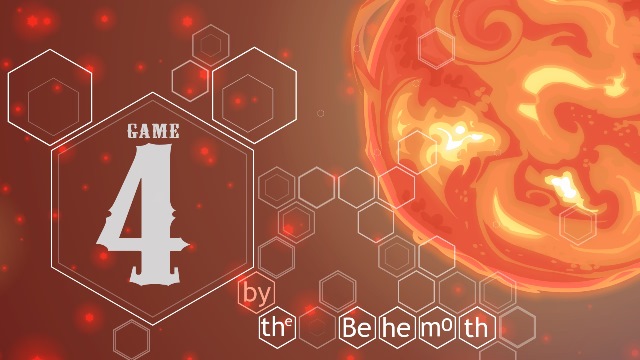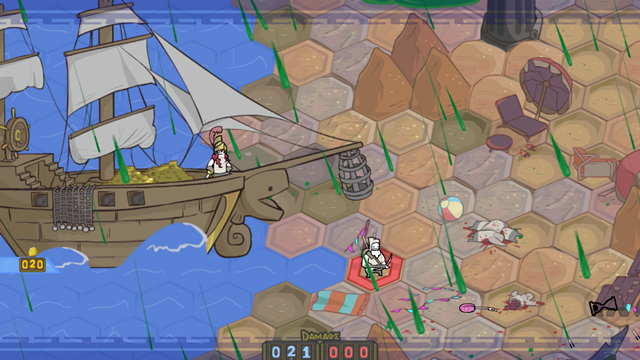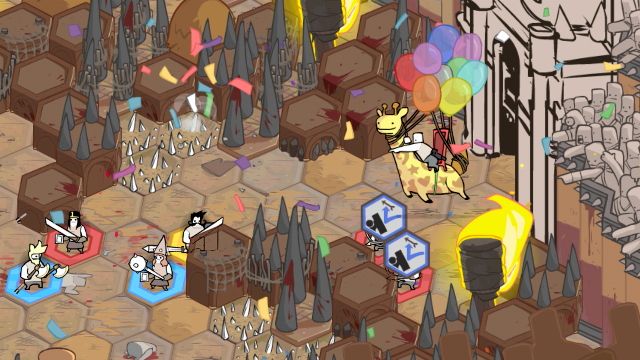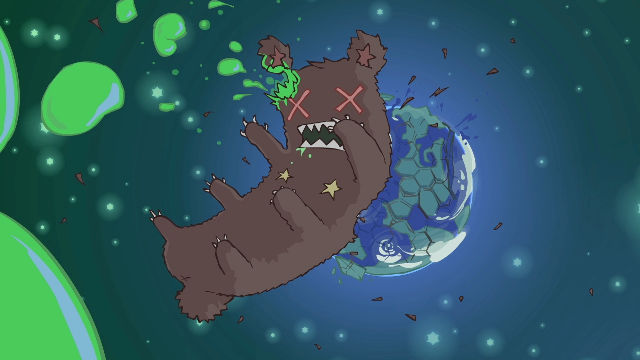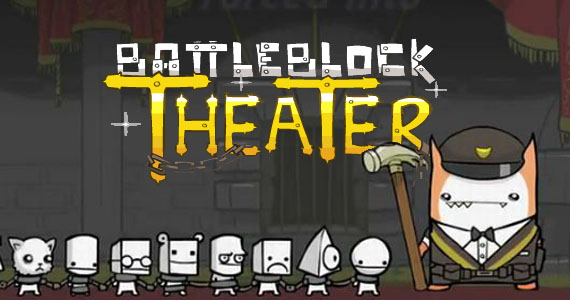Like most worlds The Behemoth has created, that of Game 4 is a little outrageous and more than a little deranged. If you know anything at all about the studio’s fourth game, it’s probably that a gargantuan, six-limbed, space-faring bear has slammed into the planet and unleashed all manner of chaos. So comically massive is this Goro-like animal that it’s a wonder anything on the hapless planet it strikes survives the impact. But survive some inhabitants do; after all, it would be more than a bit tricky to build a turn-based strategy game without a plethora of units to conscript and command.
Though the early section of Game 4 on display at PAX East is brief, we see or hear about units as varied as humans, trolls, robots and some sort of living cupcake creatures. Yeah, cupcakes. Playes are given control of Horatio, a simple blueberry farmer and father of one. The extravagantly mustachioed Horatio is forced to take up arms when a band of “Child Eaters” threatening to — what else? — eat his child show up alongside an unseen narrator hurling threats at him. Before you know it, green bear blood pours down from the sky and destroys Horatio’s house, killing his son in the process. It’s as dark as it sounds.
At least, it would be if not for the fact that Game 4 is also utterly goofy. In a repeat performance from his turn in The Behemoth’s BattleBlock Theater, narrator Will Stamper uses his absurd, tangent-filled rants to bring the funnies while also making you question whether or not it’s appropriate to chuckle after witnessing a child being disintegrated by caustic alien bear blood. Of course, this sort of irreverence is nothing new for The Behemoth. Castle Crashers had poop-propelled deer mounts, a literal catfish that coughed up hairball projectiles and princess make-out sessions. Then there was BattleBlock Theater, for which the setup was a group of anthropomorphic cat overlords forcing shipwrecked sailors to perform in a deadly game show. Game 4 is clearly being made from the same mold.
My only means of conveyance
Dan Paladin has served as the main art director for all of The Behemoth’s games, and it shows. But you get the sense that even were Game 4 bereft of Paladin’s bright and charming visuals, you’d still pick up on the connection to the studio’s other games, despite the fact that they are all set in different genres. Production Coordinator Ian Moreno agrees that The Behemoth’s titles all carry a similar tone, but he’s not entirely sure how that happens. Or even whether or not it’s on purpose.
“It’s very much…” he says before pausing a few seconds to search for the answer, “there’s an overall feel and vibe. It’s not just a platformer or a shooter or a turn-based strategy [game]. There’s always more to it, and, yeah, that’s a really tough question. I think it’s just in our DNA, whether it’s the humor and the way we present things, we like to present things very differently.
“When you look at say, how we design our HUD or something, it has to have a little more nuance to it, whether the nuance is just humor or is just offbeat or different.”
The process sounds uncoerced. The result is the type of inane and random humor that’s usually only amusing to those who are part of a specific office’s culture somehow finds its way into these games, and it’s somehow funny to everyone. As an example, Moreno mentions “the giraffe guy,” an Uzi-wielding character who flies around on a giraffe suspended by balloons. He seems right at home in a Behemoth game.
“Dan [Paladin] and I were just sitting late working on the game, just making jokes, and this illustration just manifested on my whiteboard,” recalls Moreno. “‘What if there’s this giraffe, and it’s this and this?’ Suddenly, there are just these moments in the game, so a lot of this merging of office humor just finding its way into the game.”
You get the impression that anyone on staff can approach the rest of the team with a crazy idea and ask them to make it work. Poor old Horatio the blueberry farmer is proof that that’s sometimes exactly what happens. “There was always this guy Horatio, but he was just a farmer, but that’s one where Will [Stamper] went to create a line and was just like, ‘He’s a blueberry farmer!’ exclaims Moreno, laughing. “It’s great, because there are these points where we all inspire each other. So [Stamper] writes his line, and now Dan [Paladin] is making blueberry art for the level.”
Have sword, will travel
Game 4 itself arose in a similarly casual manner, only it was Paladin with the zany idea that led to it almost accidentally becoming a strategy game. Paladin drew some sketches and, according to Moreno’s memory, he asked, “‘What if you had a team that went up against another team, but you didn’t know what the other team had?’ Just very simple. Just, you hit a button and things happen.’ That was the early concept. It wasn’t necessarily strategy or turn-based, but just team building and a kind of simplified response.”
It’s true that The Behemoth has attempted to put its stamp on a different genre with each of its games, but, despite its tonal connections to its predecessors, Game 4 is perhaps the most different yet. The studio’s other games have been action heavy, with everything moving in real time. In Game 4, you take turns, plotting out your units’ movements and then watching passively as they finish their turn by freely attacking whatever is in range. But no one ever sat down and decreed that the studio should make a game like that. The idea of building a team guided The Behemoth towards strategy, and then the hexagonal tiles on which the units move. Once the developer had gone that far, it finally became clear that it was designing its first game with turn-based combat. That meant building new systems — lots of them. Moreno is frank when asked if that’s been a challenge.
“Dude, you don’t even know,” he says, shaking his head with a look that says he himself barely even knew the work would be so draining. “Again, going back to the strategy, the amount of values and balance for what’s going on for something that looks very simple, the amount of balancing that goes on underneath the hood is like, ‘Whoa, what did we get ourselves into?’ But it’s fun, and we do the best we can to balance as we go and run a lot of simulations as well.”
You could accurately describe any Behemoth game as “approachable,” and the studio wants the same to apply to Game 4. That means balancing things not just so that they work, but so that they work for anyone, even novices and young children. Limiting the amount of commands players need to input to engage in combat is one way to accomplish that goal. Moreno believes that even a child could mash his way through Castle Crashers, and he thinks this approach will again allow for as much in Game 4. Since turn-based strategy games have historically not been easy for newcomers to grok, making an accessible one seems like it would be more difficult than creating a side-scrolling platformer or shooter for everyone. As mentioned, The Behemoth’s solution is to let game’s AI take over after units are moved, directing them to attack entirely on their own as soon as they’re in range of enemies. Not wanting to alienate the core gamer, Moreno is sure to mention that there’s also another layer to consider for those looking for one.
“So that was the early mechanic in terms of simplifying that,” he says. “But for strategy gamers, there is a deeper gameplay there for those who want to delve into it in terms of how positioning can make or break a game, which could be related to leveling up and getting health or how you move that maybe draws out the enemy unit and allows you to isolate that unit and take them down one by one. There’s a lot of deeper strategy, but on the surface it’s very, ‘I press this button, and I press this button and maybe this button.'”
The Behemoth’s ordeals don’t end at balancing its game for those two disparate audiences, either. Game 4 is also packed with more story than any previous game the developer has released, “so there’s a crap-ton of writing involved,” says Moreno. “Some of the top-level narration stuff, we get together with Will Stamper, our narrator, and we basically just come up with a story outline, and then he just writes all his own dialog, because that’s what he’s good at. It allows him to improv a lot of lines, but then we’re also writing all the in-game dialog.”
Space oddity
When told that The Behemoth’s approach to game design as a whole, not just dialog, sounds a lot like improvisation, Moreno doesn’t dispel the notion, but he does say it’s not something that anyone is going out of his way to encourage. “It just happens. It just happens, you know? Or like I’ll just make some weird sound and put it in the game, and Dan [Paladin] goes, ‘Oh, I want it too. Now we have to do this!’ There are a lot of examples like that, and it’s just sort of manifested itself over the years.”
The designers bounce whacky ideas like that off each other, then figure out how to coalesce these loose thoughts into a cohesive game. They haven’t volunteered ideas for everything, though. There’s the whole subject of that name, for instance. Game 4 is obviously a placeholder title, but does The Behemoth already know what the name will be? Is the studio only withholding it as part of its marketing and public relations strategy? Not exactly.
Moreno says the team doesn’t start its projects with a title for them in mind; it waits for the team’s crazy thoughts to become a crazy game, and then the game tells them its crazy idea for a name. So while gamers wait for the release date — Moreno says they won’t have to wait as long as they did for BattleBlock Theather, but that the release won’t be “like next week or anything” — The Behemoth is waiting right along with them for the name to reveal itself.
“Because there’s so much story and so much complex story with celestial rain and bears and things from different time eras and different dimensions and different creatures, it’s definitely more as we explore and stretch out the story, the game is going to tell us what the name is,” he explains. “I like to compare it to writing music. You don’t go, ‘I’m going to write blabbedy blah, blah, blah.’ And then you make the song. It’s like you write a song, maybe write some lyrics or maybe some instrumentals, and then something falls out of that. So it’s definitely that approach for now.
“And we just can’t think of anything — nah, just kidding.”

